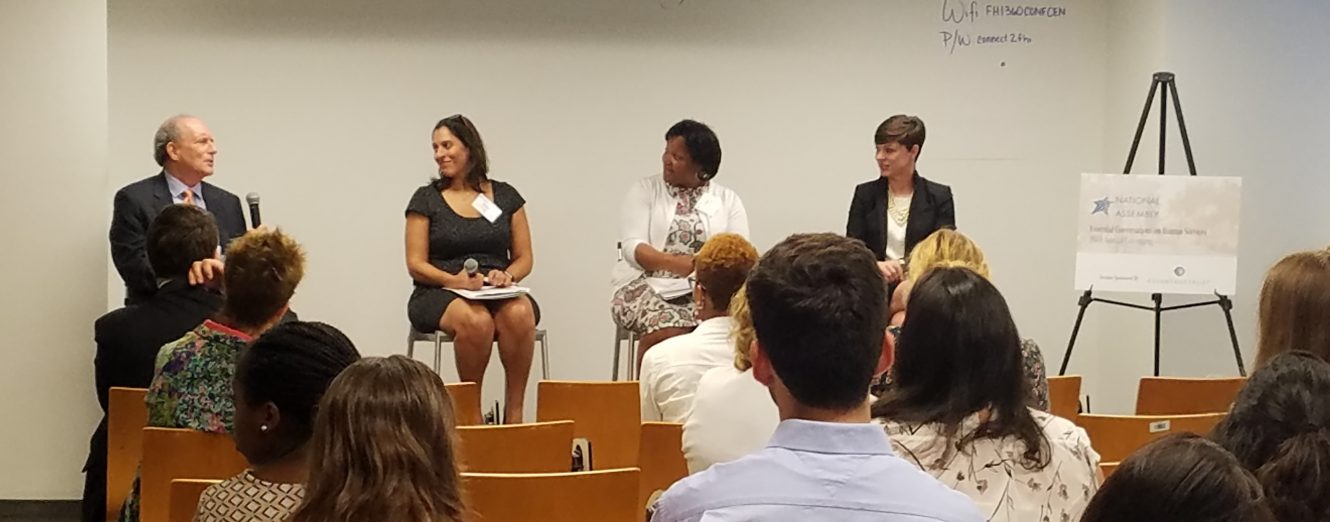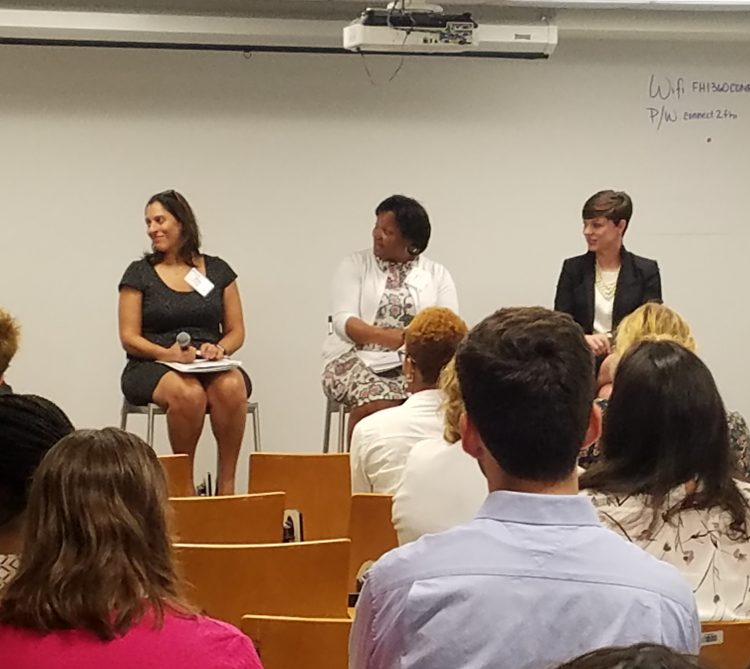Reaching Sound Policy Choices in a Post-Factual Political Culture
June 21, 2018By Brandon Toth
How can human service advocates navigate the current environment to further policy and systems change in our communities? On Wednesday, June 13, we posed this question to a panel of experts during the National Human Services Assembly’s Annual Convening: Essential Conversations on Human Services. We were very pleased to have Karen Howard from First Focus, Corey Williams from the National Education Association (NEA), and Shaena Fazal from Youth Advocate Programs (YAP), Inc. join the panel, which was moderated by Lee Sherman, from the National Assembly.
We used our time to explore the relationships between policy arguments that rely on data or evidence and policymakers’ obligation to their constituents and accountability to facts. The panel shared their experiences across issue areas, discussed how they engage with policymakers at the federal, state and local level, and addressed the challenges of leveraging evidence and data in highly partisan environments.
We Unpacked Our Adjectives
Mr. Sherman initially asked the panel to test the assertion that the current political culture is “post-factual” and what that phrase means. Karen Howard noted that even if it might be difficult to measure this idea, at the very least she can feel it in the way policymakers are attempting to demonize their opponents. The collegial atmosphere that existed in Congress as recently as 10 years ago is gone. This hostility in political debate also impacts how policymakers and their constituents treat children and families. For example, in the immigration context, when policymakers say they don’t like undocumented adult immigrants, they are implying they don’t like, or care, about their children either. Similarly, advocates often raise the issue of child poverty in our country, but we only spend eight percent of the federal budget on child poverty when children make up 22% of the population.
Corey Williams noted that this is less about facts not mattering, and more about rejecting, or picking and choosing, which facts to believe. This is increasingly prevalent in the current Administration. As a result, NEA has shifted to relying more on the division of government to counterbalance some of the most egregious actions by the executive branch. For example, after the Secretary of Education proposed to cut education funding by $9 billion and funnel other funding to private schools, NEA and others relied on their political action committees (PACs) to successfully lobby Congress to increase the federal budget for education.
At the state level, Shaena Fazal explained how the dismissal of facts has long justified oppression and bad policy in the juvenile justice sphere. The difference now is that many leaders feel emboldened to take pride in being dismissive of fact-based arguments and are more likely to make emotional appeals to their constituents. In Illinois, a debate class for prisoners was recently cancelled because it was supposedly not “evidence-based.” Ironically, there is overwhelming research, evidence, and data showing that the system of incarceration in our country has a negative evidence base, so instead of cancelling debate class, why aren’t we talking about cancelling prisons?
They Blinded Us with Science
On the topic of evidence, Mr. Sherman noted that the old paradigm was the more evidence, the more federal funding a program would receive. He asked how the landscape for evidence changed, and how has this shifted the sector’s approach to advocacy. Ms. Williams provided an example in the immigration context. Over the last several years, making macroeconomic arguments has been more effective at getting the attention of lawmakers. The University of South California created an online tool that shows how many DACA recipients reside in each congressional district and includes the amount of gross domestic product (GDP) that the district would lose if those DACA beneficiaries were to have their work eligibility revoked. In the context of home-visiting, Ms. Howard outlined how the term “evidence-based” has become almost a pejorative amongst conservative policymakers who are intent on shrinking overall federal spending. In response, organizations like First Focus have taken to highlighting the benefits of programs like home-visiting for the workforce and employment. This is a balance, however, because an over-emphasis on workforce development can lead to proposals to qualify eligibility for programs with work requirements. First Focus has made a point to show the benefits of programs like home visiting to rural families, and other populations who may be often overlooked. Further, in their advocacy work, human service organizations must prioritize how programs are interrelated, which helps them to produce positive outcomes.
Ms. Fazal encouraged the group to also consider the ways in which “evidence base” can sometimes be a restrictive term. It’s possible that, historically, putting a premium on “gold standard” random control trials, which are often impossible to implement, has permitted the field to overlook other methods and programs that are equally, if not more effective. In juvenile justice, there are prominent examples of programs that were widely accepted as evidence based, but the impact of those programs was limited because stakeholders lacked the cultural competency needed to properly engage with the communities they served. YAP, Inc. has also relied on economic arguments to facilitate system-wide change. In Marion County, Indiana, a demonstration project was implemented to send “high-risk” justice-involved youth to YAP instead of youth prison or a residential program. Over 18 months, the county saved more than $1.6 million dollars and the program is now being scaled up statewide. This example is notable for two reasons, the program was successful even though the evidence is not at the level of randomized control trial and the funding for the program flows through community-based organizations, which are best-suited to address the needs of the people they serve.
These anecdotes highlight strategies for moving away from a rigid evidence-based policymaking approach. Even with respect to home visiting, which has a robust evidence base, some Members of Congress are pushing for an even more rigorous “top tier” standard of evidence for the program. Human services also illustrate the practical challenges of setting up a control group to rigorously test a program or service. Local agencies are loath to assign families with a genuine need for services into a control group where they will receive none. Instead, they may often direct them to another set of services, perhaps in an adjacent community. However, the outcomes received by the families that are enrolled by that agency are “lost” because there is ultimately no comparison group against which to measure the results.
2+2=5
In the current landscape, it may be easy to find our organizations in competition with other human service organizations or advocacy groups. What are some strategies to avoid this and work more collaboratively?
NEA and First Focus are both members of the Committee for Education Funding (CEF), a coalition of more than 125 organizations that’s core purpose is advocating for the entire continuum of education. CEF members share resources and lobby together, and the focus is on growing the pie rather than slicing it because each element of the education continuum depends on all the others being strong. Ms. Williams also leads the Immigrant Youth Coalition which brings together a diverse set of organizations that don’t typically work on the same issues. The Immigrant Youth Coalition can actually increase the capacity of smaller organizations by providing resources like lobbying through larger organizations like NEA.
In this post-factual climate, making sure that Members of Congress are accountable for the results of their policy choices is paramount. When the Dream Act was introduced in the House in 2017 more than two-thirds of the Members had never taken a vote on any immigration bill. So, rather than explain how education funds are spent, or how certain programs like DACA benefit immigrants, show them how, by inviting them into schools in their district and interacting with young people.
Federal advocacy in juvenile justice and child welfare are different because much of the funding comes at the state level, though federal funding is still critical. For example, youth justice advocates have been working to pass the Juvenile Justice and Delinquency Prevention Act since 2007, without success. At the same time, there has been progress with legislation like the Family First Prevention Services Act (FFPSA) which was somewhat surprisingly included in the fiscal year 2018 federal spending package. When implemented, FFPSA will have a positive impact on families and dramatically change the child welfare system by giving more dollars to the community level than even the state level.
During the Q&A, the group raised other ways in which the administration continues to chip away at current systems to further its political agenda. For example, the Department of Education’s Office of Civil Rights, which is responsible for collecting data about student demographics, does not obtain reliable information about certain marginalized communities such as transgender youth. These misrepresentations can harm the enforcement of law and availability resources to such groups. More than ever, organizations are looking for other mechanisms, like litigation, to enforce the law. Coalitions of groups have filed suits in the context of border detentions, the right to public education, among many others. On the legislative side, finding openings to bring truly bipartisan legislation is also important. But, in such a partisan environment, “bringing a partner to the dance” to ensure an equal number of both Republican and Democrat co-sponsors for a bill to stand a chance of passing, particularly in the House.
As Mr. Sherman noted at the outset of the session, this discussion is one intended to continue beyond the scope of our convening. The strategies identified during this conversation should be shared and acted upon in our own organizations. If you have feedback about this session or would like to get in touch with anyone from the panel, please contact Brandon Toth at btoth@nassembly.org.



